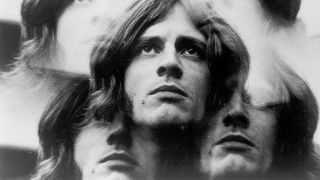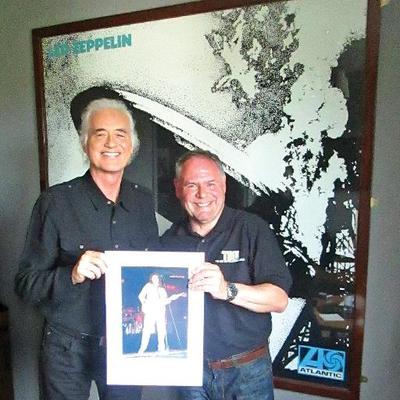With a pedigree in studio sessions and arranging – working with the likes of The Rolling Stones and Dusty Springfield, plus influences ranging from Miles Davis to Motown – John Paul Jones was always going to bring something special to the role of bassist and keyboards when he teamed up with Jimmy Page, Robert Plant and John Bonham to form Led Zeppelin.
Such was his multi instrumental talent, he was able to bring a unique musicality to the group adding synths, mellotron, mandolin and much more to their sound. He may have been the quiet unassuming one, but his vast contributions echo loudly across their ten album legacy. Here are ten of John Paul Jones’s greatest Led Zeppelin moments.

Your Time Is Gonna Come (Led Zeppelin I, 1969)
Alongside his prowess as a bassist, Jones was more than proficient on keyboards. This opening track on side two of Led Zeppelin's debut album was an early showcase of his talent. From its church like Hammond organ intro through to the hypnotic fade, he dominates throughout. John also arranged the backing vocal parts on the repeated chorus.
The Lemon Song (Led Zeppelin II, 1969)
As for his bass technique, this ramshackle rendering of Chester Burnett’s (aka Howlin’ Wolf) Killing Floor from Led Zeppelin II is held steady by his dextrous Fender Jazz bass playing. Its presence is very evident from around the two minutes 49 mark. Following Plant’s cry of ‘’Take it down a little bit’’ John Paul Jones takes centre stage, becoming the lead instrumentalist for much of the rest of the song.
Black Dog (Led Zeppelin IV, 1971)
John Paul Jones’s shared song writing credit with Page and Plant is clear indication of his contribution to this Led Zeppelin IV opener. It’s his complex linear bass riff influenced by John Lee Hooker’s Smokestack Lightening that Jimmy Page builds his guitar histrionics around. The almost impossible-to-copy rhythmic swing of the track (4/4 time set against 5/4) owes much to Jones’s ability to weave through the time signatures.
No Quarter (The Song Remains The Same, 1976)
This brooding keyboard led extravaganza – a highlight of the 1973 Houses Of The Holy album – became a vehicle for all manner of on stage improvisation from John Paul Jones. The live version from their Song Remains The Same movie soundtrack is a vivid example of the sheer invention Jones brings to proceedings. He takes the basic solo and extends it into a jazzy excursion playing off Page’s intricate solo. Masterful.
Trampled Under Foot (Physical Graffiti ,1975)
Inspired by the likes of Stevie Wonder’s Superstition and Billy Preston’s Outta Space, Jones’s incessant Honer clavinet playing adds the necessary funk to Page’s relentless riffing and Plant’s captivating word play lyrics. Kool And The Gang never sounded as cool as this.
In The Light (Physical Graffiti, 1975)
An eight-minute Zepic built around an inspired rotating John Paul Jones keyboard drone. A rock equivalent of the bagpipes, and, as bizarre as that sounds, it works perfectly in the hands of Mr Jones. The clavinet is back in evidence on the climatic final fade, cascading around Page’s multi-dubbed guitar solo.
Going To California - (Led Zeppelin DVD, 2003)
Another string to the bow – in this case the mandolin. John first acquired a mandolin in 1970 when Led Zeppelin inserted an acoustic set into their live act. Marvel here at Jones’s delicate finger picking technique as he perfectly complements Page’s playing on this acoustic beauty, as performed live during Zep’s five night stint at Earls Court in 1975.
Achilles Last Stand (Presence, 1976)
Another bass bonanza. Page’s performance here is one of his finest, but the way John Paul Jones underpins the main structure of the song with a pummelling bass attack (courtesy of an eight string Becvar 1 Triple Omega model) is equally inspiring. Note the way he plays off Bonham’s frenzied fills, interlocking to form a relentless, rhythmic groove.
Carouselambra (In Through The Out Door, 1979)
Arriving at the ABBA studios in Stockholm before the other members enabled John to cast a mighty shadow over their final studio album In Through The Out Door. This ten-and-a-half minute opus benefits greatly from his then new toy, a Yamaha GX1, at the time one of the biggest analog and polyphonic synths. Jones adds all manner of keyboard embellishments, from brass like riffs to funky struts, holding the show together throughout this impressive latter era epic.
All My Love (In Through The Out Door, 1979)
A Jones and Plant creation, this gentle ballad – a tribute to Plant’s late son – gave Jones the scope to showcase his classical leanings. The cluster of notes that make up the string synth solo have a definite Bach baroque influence; another example of Jones’s eclectic musical leanings.


